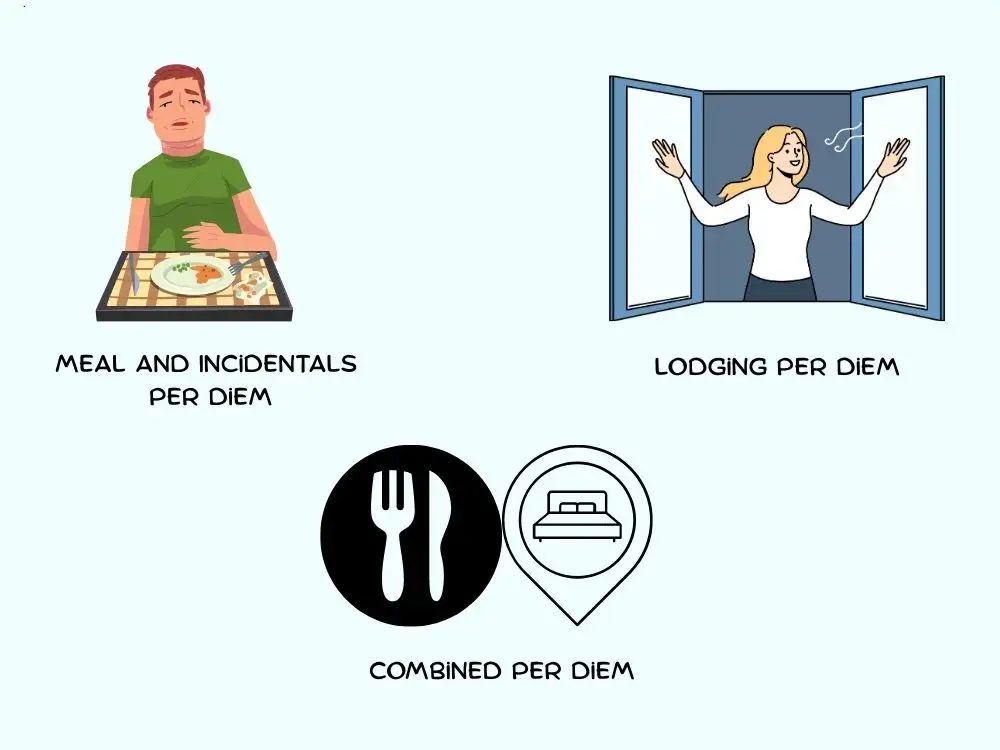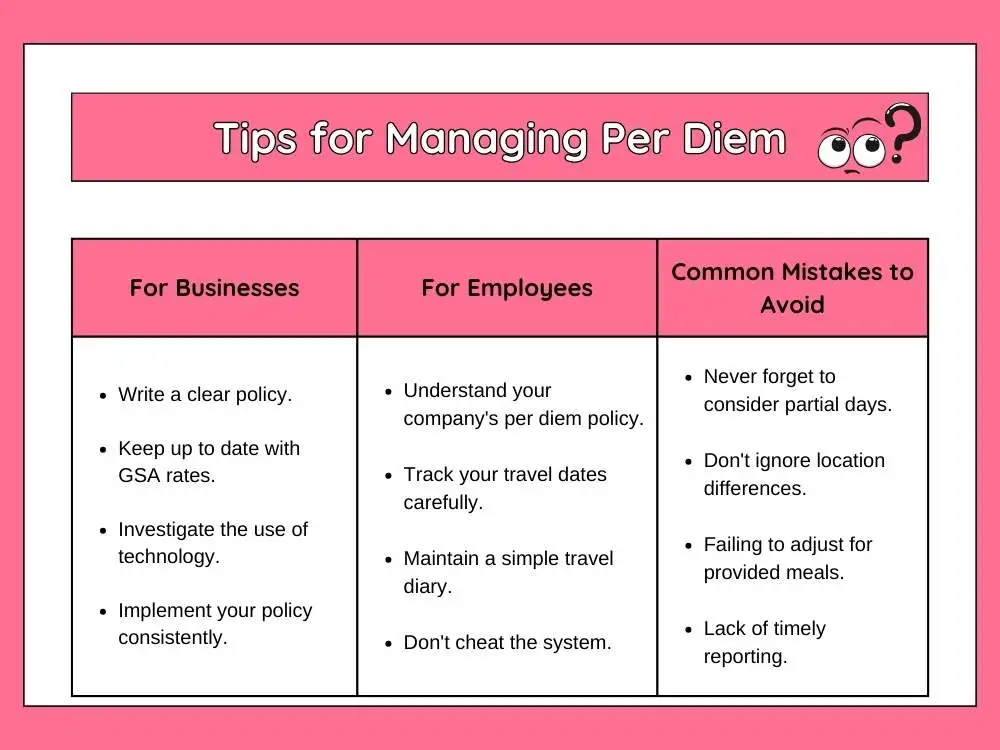
What Is Per Diem and How to Calculate It: A Complete Guide
Dealing with the headache of tracking every single expense during business trips? Per diem might be the solution you're looking for. This allowance system offers a set daily amount for the purpose of covering food, accommodation, and incidental expenses when employees travel for work.
For businesses, per diem simplifies the budgeting process. It also reduces the administrative burden of processing countless receipts. Employees benefit by receiving cash upfront without filing lengthy and complicated expense reports. Even freelancers can benefit when they know these rates as they negotiate travel expenses with their clients.
Organizations need to calculate per diem correctly to get a clear idea and manage their travel expenses, regardless of size or industry. Let us now go through how this simple approach can change an organization's business travel experience.
Key Takeaways
- Learn what pay diem means and how it works.
- Explore different types of per diem allowances and a calculator.
- Learn the key differences between per diem and traditional expense reimbursement.
- Discover tax implications and best practices for managing per diem effectively.
What Is Per Diem?
Per diem means daily allowance for expenses incurred by employees on their business trips. It's a Latin word meaning "per day". It covers meals and lodging, along with incidental expenses, all without requiring receipts for every expense. Per diem is typically used by organizations for:
- Business travel expenses for employees visiting clients or attending conferences.
- Temporary relocation expenses when staff work at remote locations.
- Contractor or consultant payments when services require travel.
- Healthcare professionals working temporary assignments.
Per diem rates can be established by companies or based on government standards for specific locations. The following table clearly shows this.
Per Diem Rates
| Location | Meals & Incidentals | Lodging | Total Per Diem |
|---|---|---|---|
| New York City, NY | $79 | $339 | $418 |
| Chicago, IL | $74 | $269 | $343 |
| Dallas, TX | $64 | $187 | $251 |
| San Francisco, CA | $79 | $321 | $400 |
| Atlanta, GA | $69 | $203 | $272 |
| Standard Rate (Other Areas) | $59 | $154 | $213 |
Note: Sample rates are based on typical government per diem allowances. Actual rates may vary based on season, specific location, and annual adjustments.
How Per Diem Works
Generally, per diem benefits are availed by any employee traveling for business purposes away from their normal work site. For example, sales representatives visiting clients, executives attending conferences, technicians sent to remote job sites, or similar scenarios.
Companies establish per diem rates in two main ways. Some firms set fixed amounts based on average costs in frequently visited locations. The other methodology is adopting the rates published by the General Services Administration (GSA), which updates location-specific allowances annually.
Moreover, the IRS maintains specific guidelines around per diem payments. When companies stay within federal per diem limits, these payments remain non-taxable income for employees. However, any amount exceeding federal rates becomes taxable compensation and must appear on W-2 forms.
Types of Per Diem Allowances
Companies typically divide per diem allowances into three categories to fit different business travel situations.

a) Meal and Incidentals Per Diem
This covers expenses like food, tips, fees, and small daily costs such as local transportation or snacks during the travel period. Various firms have varied per diem rates for different locations (A breakfast in Manhattan surely costs more than one at Omaha). The first and last days of travel are usually at a lower rate (typically 75%) since an employee doesn't travel the full day.
b) Lodging Per Diem
This involves hotel accommodation allowances that vary greatly from place to place. The reason for this price gap between hotel rates depends on location. In major cities, the cost is higher than in smaller towns. The lodging per diem usually requires receipts, unlike for meals since they are large expenses and differ greatly in price.
c) Combined Per Diem
Many firms prefer the comfort of a single day per diem for both travel and other expenses. An all-inclusive payment leaves it up to the traveler whether to spend more on food or accommodation or vice versa. Combined per diems simplify the accounts, which don't represent an accurate cost distribution in high-lodging areas.
Per Diem Calculator
It’s so easy to calculate the per diem expenses using our following calculator. Just select the location, trip start and end dates, and the type of per diem to begin.
Per Diem vs. Reimbursement: What’s the Difference?
Managing travel expenses is really a pain point for everyone concerned. Choosing between per diem allowances or the more traditional reimbursement method is very important. Each approach has its flavor, and the right choice depends on what works for your team and company culture.
The Core Differences
| Feature | Per Diem | Reimbursement |
|---|---|---|
| Payment timing | Upfront or immediately after travel | After expenses are verified |
| Documentation | Minimal paperwork required | Receipts for everything |
| Amount basis | Fixed daily rates | Actual spending |
| Leftover money | Employee keeps savings | No "extra" money |
| Budget predictability | Highly predictable | Can vary significantly |
| Administrative work | Lightweight | Heavy lifting required |
Why You Might Love Per Diem
Per diem feels like freedom where your employees get their daily allowance and can spend it as they see fit. No need to justify that morning latte or evening snack. It's simple and the beauty of per diem isn't just for travelers, though. Your finance team will thank you for the reduced paperwork and your budget forecasting becomes remarkably straightforward.
When Reimbursement Might Make More Sense
Sometimes, actual expenses tell the real story. In cities where costs fluctuate wildly or for unexpected situations, reimbursement ensures nobody's left covering business costs from their own pocket. Plus, some organizations simply need the paper trail and spending visibility that comes with detailed receipt tracking.
Tax Implications of Per Diem
The IRS actually plays nice when it comes to these payments, but only if you follow their rules. Per diem isn't taxable when it stays within federal guidelines and employees submit timely expense reports. Anything beyond those amounts gets treated as taxable income to your employees.
For employers, well-documented per diem payments remain fully deductible business expenses. When tax season rolls around, you'll report qualifying payments in Box 12 (not Box 1) of employee W-2 forms using code "L." Remember that documentation is your friend. Keep those travel records clean, and your tax obligations stay simple.
Best Practices for Managing Per Diem
Even with per diem's simplicity, there's still room for headaches if you don't manage it well. Here are some straightforward tips to keep things running smoothly.

For Businesses
- Write a clear policy. Specify what is covered under per diem, when it applies, and how employees should report their travels. Leave no room for ambiguity.
- Keep up to date with GSA rates. Since they are changed annually, old rates can create compliance problems.
- Investigate the use of technology. Modern expense management software can automate per diem calculations and make the whole process easier.
- Implement your policy consistently. Ensure your policy is applied uniformly and with flexibility in the rare case that calls for it.
For Employees
- Know before you go. Understand your company's per diem policy before you travel, not when you're already on the road.
- Track your travel dates carefully. First and last travel days typically qualify for reduced rates (usually 75% of the standard rate).
- Maintain a simple travel diary. Even without receipts, note where you went and why. This simple proof can save lots of trouble during audits.
- Don't cheat the system. Claiming per diem for days not traveling is against policy and could trigger tax implications.
Common Mistakes to Avoid
- Never forget to consider partial days. Most policies reduce per diem for the first and last day of travel.
- Don't ignore location differences. The per diem rate can fluctuate between cities or sometimes just different neighborhoods. Using the wrong rate creates problems.
- Failing to adjust for provided meals. If the conference includes breakfast, your meal allowance typically needs adjustment.
- Lack of timely reporting. Many companies require expense reports to be submitted within 30-60 days post-travel. If reports are missed in that time, per diem may turn into taxable income.
- Confusing "lodging plus" and "full" per diem methods. They're quite different systems with different rules. Know which one your company uses.
Wrapping Up
Per diem makes business travel easier by simplifying expenses for both employees and employers. It cuts paperwork and keeps travel hassle-free. Understanding rates, tax rules, and best practices helps businesses stay compliant and efficient. With the right approach, per diem can save time and streamline operations.
FAQs
Q1: Can employees choose between per diem and reimbursement?
It depends on the company's policy. Some companies allow both options, while others don't. If you think about flexibility, it's better to confirm this with your employer before traveling.
Q2: What if even the per diem cannot cover all my expenses?
Anything beyond the allowance would generally come out of your pocket. Getting organized to minimize surprises and sticking to a budget tends to help.
.webp)